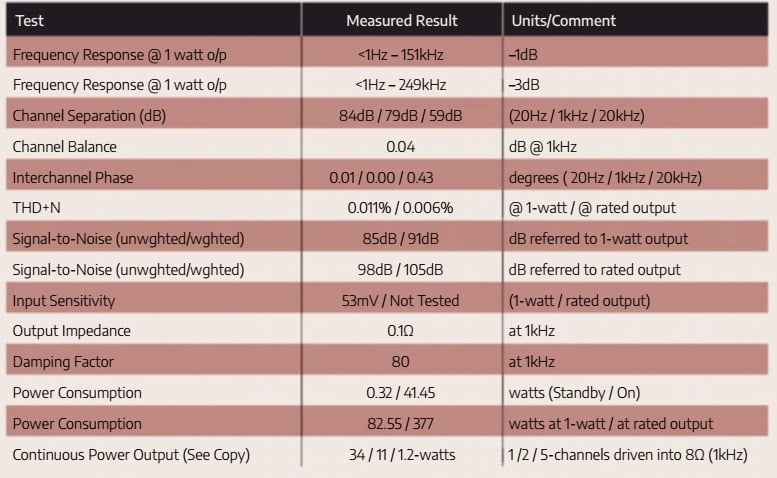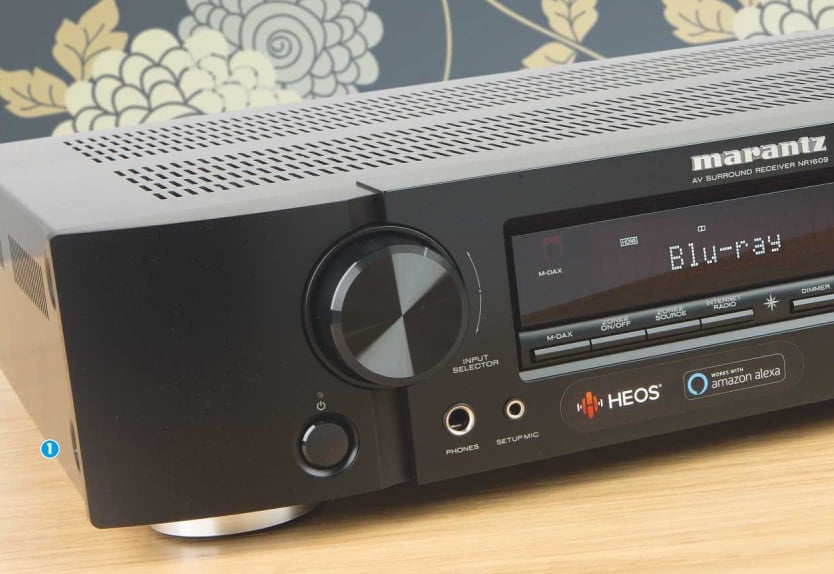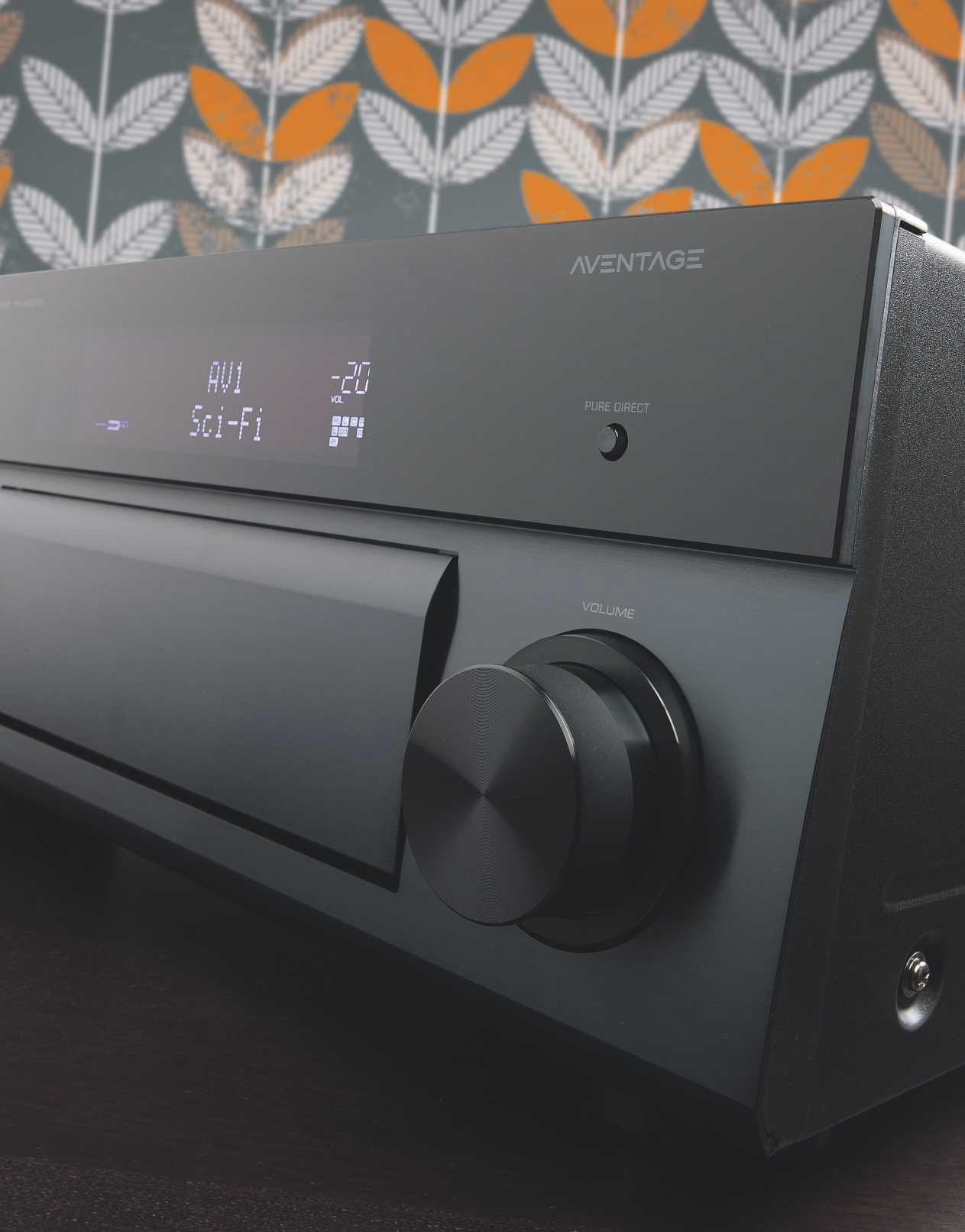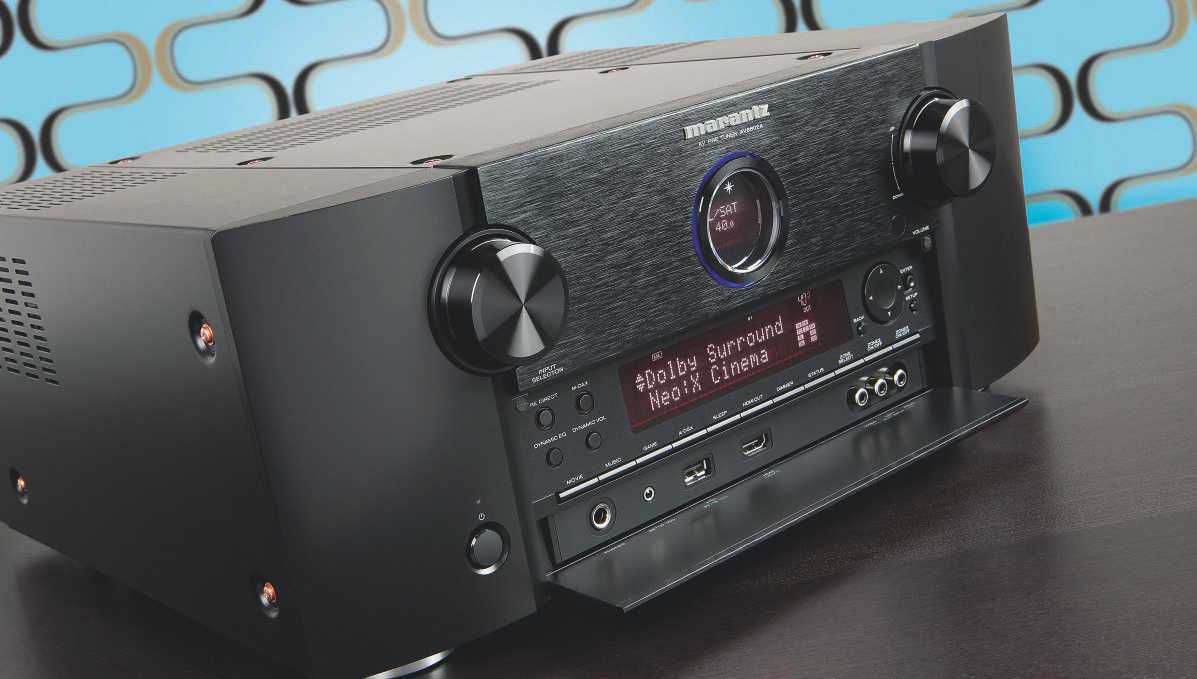Sony STR-DH790 Review
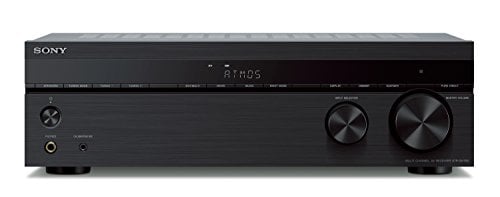
SONY STR-DH790 7.2-CHANNEL AV RECEIVER
Sony produces equipment covering just about as wide an affordability gamut as any company, and this STR-DH790 is one of its lowest-priced multi-channel AV receivers, so let’s see what features have been selected for inclusion and exclusion, given the price-point.
Table of Contents
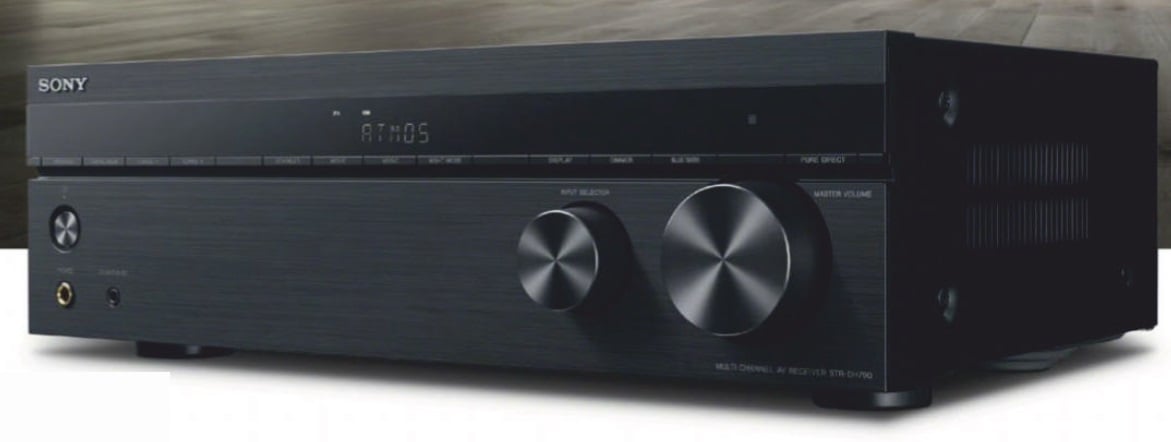
THE EQUIPMENT
The Sony STR-DH790’s seven channels are organised with sufficient flexibility to allow you to bi-amp the front stereo pair of speakers, or drive rear surround speakers or a pair of height speakers for Dolby Atmos and DTS:X, both of which are supported.
There are couple of compromises.
First, you need to stick with speakers of at least 6ohm nominal impedance in order to protect your warranty.
Second, all but the front left and right channels use spring-clip connections, not binding posts. They accept cable up to about 1.5mm thick, but I think this is a step too far in economy.
There are four HDMI inputs, all supporting all the good stuff you’d expect. According to the specs they support up to 4K and UHD at up to 60Hz, HDR10, Hybrid Log-Gamma and Dolby Vision, 3D, Deep Colour, the BT.2020 colour space, and the all-important HDCP 2.2 copy protection system. There’s a single HDMI output.
There are no analogue video connections of any kind, but four stereo analogue audio inputs, as well as one coaxial and one optical digital audio, so it’s not a generous collection, but enough to cover the requirements of most systems, and more than enough for most entry-level and middling systems. There’s also a proper 6.5mm headphone socket on the front panel.
Not included with this receiver are some things that those used to higher-cost gear might expect.
There is no support for a second zone, for example, and there is no support for media from USB (however there is a 5V/1A power supply in the form of a USB socket so you can power a phone or iPod plugged in via an analogue input).
And notably there is no support for networking at all, either Wi-Fi or Ethernet. However there is Bluetooth, which may be far more important for those seeking a receiver at this price point. It supports the AAC codec, so most Apple device users should get the best Bluetooth sound possible. It doesn’t support aptX, nor Sony’s LDAC.
So… is the lack of network support a deal-breaker? I say no. Most of the networky things AV receivers do can also be done by far less costly Blu-ray and UHD Blu-ray players. And, indeed, I used Sony’s latest $349 UBP-X700 Ultra-HD Blu-ray player—which has both Wi-Fi and Ethernet networking—with the STR-DH790, and the two units worked together pretty much as one device so the receiver became networked in this fashion. The UBP-X700 is a nice player too, delivering disc replay for CD, SACD, DVD, Blu-ray and UHD Blu-ray, with dual HDMI outputs (the second offers audio only to a non-4K compatible receiver or amplifier) plus there’s USB and network replay of audio including high-resolution, access to streaming video and audio services online, and an app available for control.

Further, much of the networking stuff may be duplicated in your TV—especially given that Sony’s own models (such as its award-winning KD65-A1 OLED) favour the Android interface which is absolutely born to network. I didn’t have the A1 to hand, but for Netflix I used the Netflix app on an LG OLED
Sony’s STR-DH790 is a sensibly-equipped receiver suitable for someone seeking 7.2-channel surround at this level
TV and had it deliver the sound to the Sony receiver via the HDMI cable using the Audio Return Channel. This arrangement worked almost as seamlessly.
IN USE AND PERFORMANCE
When you start up the receiver it presents a kind of basic user menu across the screen of your TV. This can overlay whatever video signal is being throughput, even UHD HDR BT.2020 stuff, and it can be invoked at any time with the ‘Home’ key. The four options are ‘Watch’, which lets you choose one of the four HDMI inputs, ‘Listen’, which lets you choose from Bluetooth, the FM tuner (there is no AM tuner) and SA/CD analogue or digital, ‘Easy Setup’ which invokes a settings wizard, and the inappropriately-named ‘Sound Effect’, and ‘Speaker Settings’ which allow manual adjustments to speaker settings.
The receiver comes with a calibration microphone for the auto-calibration system, which sets speaker sizes, levels, distances and EQ. This was fast and easy to use, and involves putting the included microphone in just one position. There was no check step at the end, so after it had finished I went to the ‘Speaker Settings’ and found that while the levels and distances seemed to be right, the speakers had all been set to ‘Large’, even the ceiling speakers, so I had to tweak the settings manually to tell the Sony that the ceiling speakers weren’t ‘Large’ at all.
Most of the sound- field settings ended up with a rather strong bass, much higher than that normally provided by AV receivers. Who does it right? Yamaha, Denon, Marantz on the one hand, with a more subdued subwoofer level, or Sony on the other hand, with one that’s at least 6dB louder? I brought down the bass level a little, but really, let your subwoofer’s capacity, your own taste and your neighbours’ complaints determine the optimum level for you.
So what about that ‘Sound Effect’ entry in the ‘Home’ menu? No, it didn’t generate party noises. It lets you change important things. You use it to set the ‘Sound Field’— choose things such as Dolby Surround, Neural-X, Front Surround, ‘Audio Enhancer’ (yuck), Stereo, Multi-channel Stereo and Direct. Each entry had a useful little description on screen to tell you what it does. The plethora of surround and processing modes can be daunting, so for anyone not thoroughly versed in all this stuff, this is an important feature.
Also in ‘Sound Effect’ is a ‘Night Mode’, an ‘Equaliser’ (actually, bass and treble controls) for each channel pair, and ‘Calibration Type’ from which you can choose ‘Engineering’
(the default), ‘Front Ref’, ‘Full Flat’ or ‘Off’. This sets the reference which the auto EQ curves seek to approximate. ‘Front Ref’ is for those who like their front speaker sound
relatively unprocessed and want the other speakers to conform, tonally, to them. ‘Engineering’ makes the sound match ‘the Sony listening room standard frequency characteristics’. (I got that from the online manual. The information you need is split between the printed one in the box and the online manual.) Finally, in ‘Sound Effect’ is a Pure Direct setting.
An ‘Options’ key invokes another onscreen menu offering things such as AV Sync and further soundfield changes, while an ‘Amp Menu’ button brings up a menu on the front-panel display. Initially I was thinking Sony had stepped back by a decade to how things used to be done, adjusting while peering at the display on a receiver, but it turns out that most of the settings merely duplicate things available in the on-screen menus. And since most are adjustments for sound—such as speaker levels and so on—the Amp Menu could be useful at times when you don’t have the TV switched on. (Although some of the non-duplicated things were HDMI settings and so on.)
There were some wrinkles with the HDMI equipment I used. Specifically, neither of my Beyonwiz PVRs would work with the HDMI input labelled BD/DVD. Both worked perfectly with the Game and Media Box inputs. The Beyonwiz T4 also worked with the SAT/CATV input, but while the picture came through from the T3 on that one, the sound wouldn’t. I tried different HDMI cables. No idea what was going on there. The BD/DVD input worked fine with the Sony UBP-X700 and my own selection of UHD and Blu-ray players. A useful button on the remote displays video and audio signal information on the screen, so you have some information to work with.
And the sound? I installed my speakers as a basic 5.1.2 Dolby Atmos layout. As I’ve remarked before, the difference for one listener between two overhead speakers and four seems to be minimal.
And the speakers I was using weren’t demanding. The Sony auto-calibration did a good job tonally with the sound. And I was able to just enjoy some really classy results. When it came time for me to watch ‘Blade Runner 2049’ on Ultra-HD, I was tempted to go back to a very immoderately priced receiver, but I persisted. This receiver did the job very thoroughly. The sound engineers had obviously enjoyed their time at the surround mixing panel, using the Atmos object-oriented capabilities to have Ryan Gosling’s flying car zoom in from my left shoulder, overhead and to slightly right of centre up front. Could it have been done better by a more expensive system? Oh, I guess, but it happens fast and it happened convincingly via the Sony.
As for music, again the results were very strong so long as I remained within the capabilities of the receiver and used speakers suited to it… and switched the sound of stereo music to ‘Stereo’ or ‘Direct’ or to ‘Pure Direct’, rather than the silly ‘All Channel Stereo’ default.
Can you cheat and go with 4ohm speakers if you already own them? I would never recommend that you do, of course. But if you must, then just be cautious with levels. The Sony has excellent output stage protection circuitry, including a heatsink temperature monitor.
CONCLUSION
If the inputs suffice and the spring-clips don’t deter, then Sony’s STR-DH790 is a sensibly-equipped receiver suitable for someone seeking surround at this level, and especially so in combination with other Sony components. Stephen Dawson
CONTACT DETAILS
Brand: Sony Model: STR-DH790
Distributor: Sony (Australia) Pty Ltd Address: Level 3,165 Walker Street North Sydney NSW 2060 T: 1300 720 071 E: [email protected] W: www.sony.com.au
- Good sound performance
- Bluetooth with AAC
- Lowish entry cost
- Spring-clip speaker terminals
- Not rated to drive 4ohm spkrs
- No networking or AM radio
Readers interested in a full technical appraisal of the performance of the Sony STR-DH790 7.2-channel AV receiver should continue on and read the LABORATORY REPORT published on the following pages. Readers should note that the results mentioned in the report, tabulated in performance charts and/or displayed using graphs and/or photographs should be construed as applying only to the specific sample tested.
LABORATORY TEST REPORT
Measuring the power output of the Sony STR-DH790 proved a little problematical because Sony has built in an automatic circuit to prevent the output devices from overheating. This means that the power output of the amplifier is completely dependent on the temperature of the rather small heatsink inside the unit. This heatsink relies on passive radiation—it is not fan-cooled. When this heatsink’s temperature is lower than 25°C, Newport Test Labs found that the Sony STR-DH790 will deliver 162-watts per channel into 8ohm with one channel driven and 136-watts per channel into 8ohm with two channels driven.
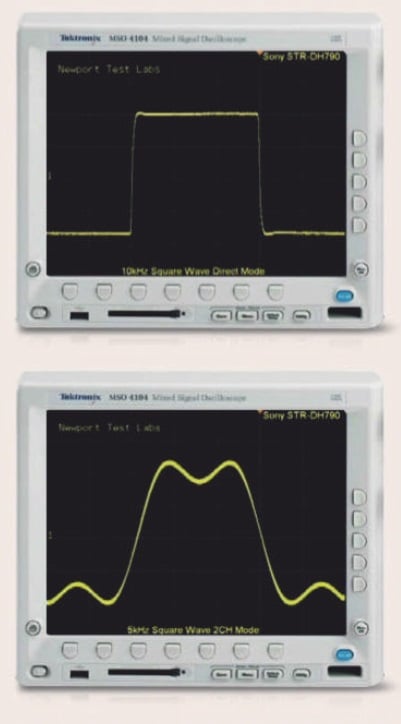
However, the Sony STR-DH790’s output stage can sustain this power output only for a minute or two, because this rather high power level causes the temperature of the small heatsink to rise rather quickly, which in turn triggers the internal thermal protection circuit, which then cuts in and dials back the output power by about 10 per cent. Then, after approximately 10 seconds, if the heatsink’s temperature continues to rise, the circuit dials back the output power a further 10 per cent, and after another 10 seconds or so, it dials it back another 10 percent… and then continues to clamp down the output power until, after about five minutes, the amplifier ends up delivering 11-watts per channel into 8ohm (both channels driven). If the heatsink is not allowed to cool down (by reducing the output power below 11-watts per channel), this becomes the Sony STR-DH790’s maximum power output into two channels. When driving five channels, the continuous power output able to be sustained drops to 1.2-watts per channel.
Of course this behaviour will be exhibited only when the amplifier is reproducing continuous high-level signals, which only occurs during laboratory testing. When replaying music or movie soundtracks, the heatsink will not heat up nearly so much, even during extremely loud passages, and will cool down during quieter passages, meaning that the Sony will be able to deliver sufficient power that the output stage will be able to deliver high sound pressure levels and never go into clipping during transients even if you’re playing loud programme material for long periods. However, the actual power available will vary depending on how many channels are playing at the time (as the output devices for each channel are attached to the same heatsink), how loud you’re playing your music (or movie) and the ambient temperature in the room itself (the higher
The Sony has excellent output stage protection circuitry, including a heatsink temperature monitor that limits power output if the heatsink gets too hot…
LAB REPORT
Sony STR-DH790 7.2 AV Receiver

Graph 1. Total harmonic distortion (THD) at 1kHz at an output of 1-watt into an 8-ohm non-inductive load, referenced to 0dB. Measured in ‘Direct’ two-channel mode.

Graph 2. Total harmonic distortion (THD) at 1kHz at an output of 20-watts into an 8-ohm non-inductive load, referenced to 0dB. Measured in ‘Direct’ two-channel mode.
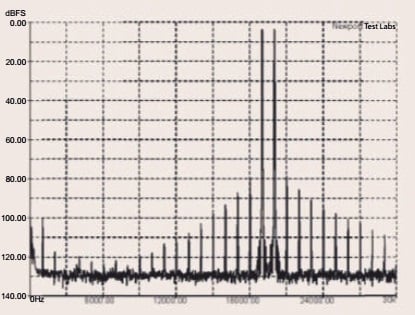
Graph 3. Intermodulation distortion (CCIF-IMD) using test signals at 19kHz and 20kHz, at an output of 20-watts into an 8-ohm non-inductive load, referenced to 0dB. Measured in ‘Direct’ two-channel mode.
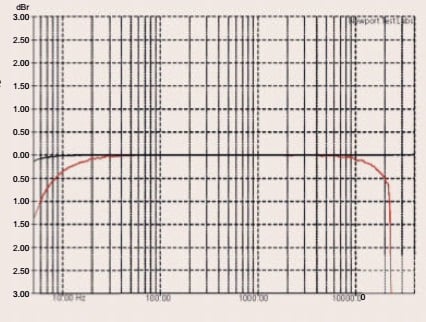
Graph 4. Frequency response at an output of 1-watt into an 8-ohm non-inductive load, referenced to 0dB. ‘Direct’ two-channel mode (black trace) vs ‘2CH’ mode (red trace).
the ambient temperature in your room, the less efficient the internal heatsink will be at dissipating heat).
It should be made perfectly clear at this point that all multi-channel AV receivers have circuits of one type or another that limit power output in certain conditions (including when multiple channels are driven, rather than just two), so Sony is doing the same thing as all other manufacturers of AV receivers. (There are some exceptions to this rule, but they’re all extremely high-priced.)
Newport Test Labs had a different issue when it came to measuring frequency response, signal-to-noise ratio and other facets of the Sony STR-DH790’s performance because unless you use the ‘Direct’ or ‘Pure Direct’ modes, all input signals are converted to digital inside the unit for processing, and then back to analogue for final stage amplification, a process that limits the upper frequency response to just 24kHz (suggesting that the digital circuitry being used has a sampling rate of only 48kHz), the signal-to-noise ratio to 80dB (referred to rated output) and also results in increased distortion and reduced channel separation.
Signal-to-noise ratios were excellent in the ‘Direct’ mode as you can see from the tabulated results. By way of comparison, whereas the Sony delivers an excellent 105dBA S/N result in ‘Direct’ mode, it managed only 80dBA in 2CH mode under the same test conditions.
Square wave performance was outstandingly good in ‘Direct’ mode, and exactly as I’d expect in ‘2CH’ mode. The two graphs accompanying this review show a 10kHz square wave reproduced in the ‘Direct’ mode and a 5kHz square wave reproduced in ‘2CH’ mode by way of comparison. You can clearly see the limitations introduced by the analogue/ digital/analogue conversion process.
Tested using the ‘Direct’ mode, the Sony STR-DH790 returned excellent performance and it’s the results from these tests that are tabulated in the accompanying Test Result table. You can see that the frequency response was superbly extended, stretching from below 1Hz to 249kHz -1dB. The response across the audio band is shown in Graph 4 for both the ‘Direct’ mode (black trace) and using the ‘2CH’ mode (red trace).
The graphs of THD at one watt and ten watts, and IMD at one watt(Graphs 1, 2 and 3) all show the Sony STR-DH790 has very low levels of distortion, which is reflected in the tabulated figures. Steve Holding
Sony STR-DH790 – Laboratory Test Results (Direct Mode Only)*
